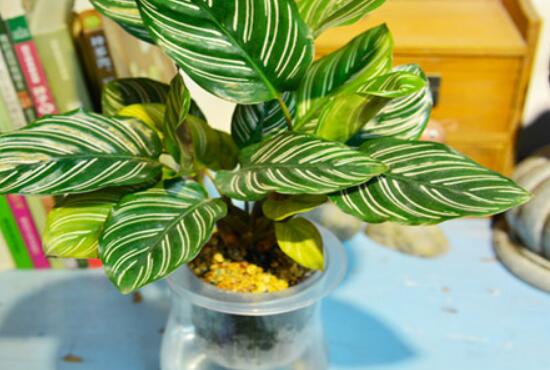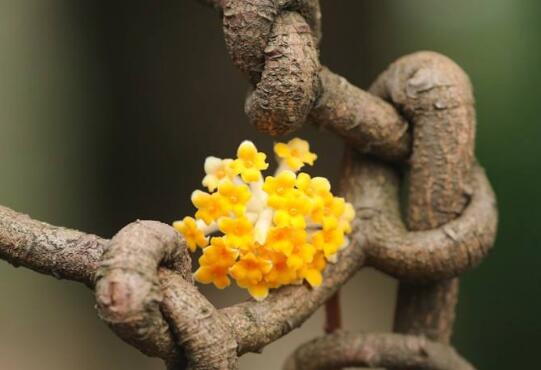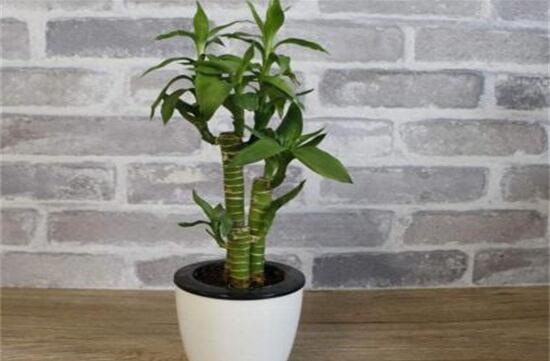Can double-line taro be cultured in water? the culture method of double-line taro in water culture / change the water once every 2 days.
As a beautiful foliage plant, double-line taro has many functions, it can be both ornamental and medicinal, and is deeply loved by flower friends. However, compared to soil culture, many flower friends prefer hydroponic culture, can double-line taro be hydroponic? If you can, how can double-line taro be hydroponically cultivated? Next, let's go with the editor to take a look at the culture method of hydroponic double-line taro.
Can double-line taro be hydroponically cultured?

Double-line taro likes a humid environment, and its vitality is tenacious, even if a leaf is inserted into the water, so can double-line taro be hydroponically cultivated? Obviously, you can. We can directly soil culture double-line taro, directly into hydroponics, ornamental value is higher oh ~ specific operation methods, we continue to look down.
Second, how to cultivate double-line taro in water
1. Hydroponic container
If you want double-line taro to be hydroponically cultivated, you must first choose a container, and in order to be beautiful and observe its growth, the editor recommends that you use plastic pots or ceramic flowerpots or glass products, which should be transparent and good-looking anyway.
2. Water-cultured seedlings / root washing
Choose the double-line taro with strong growth, no yellow leaves, bright colors and no diseases and insect pests, and remove it from the basin. Prepare a basin of water and put the unboiled plants into it. The water level is preferably up to 1-2-2 of the root system, leaving the soil loose and falling off. After that, we gently wash off the fine soil stuck to the roots with clean water, and the plants we get are the water-cultured seedlings we need.
Plant treatment: after cleaning the water-cultured seedlings, cut off all the dead leaves and old roots, and then soak them in 1% potassium permanganate solution for one hour, in order to disinfect and sterilize and promote the early growth of new roots.
3. Hydroponic culture begins
How to cultivate double-line taro in water? After doing the above preparatory work, the dead leaves just began: the water-cultured seedlings were planted in a container, but how high is the water level of hydroponic double-line taro? You can add clean water to make the root system of 1GUR 3mi 1P 2 come out of the water.
Third, the culture method of hydroponic double-line taro.
1. Hydroponic environment
After the completion of double-line taro hydroponics, there may be a phenomenon of double-line taro leaves curling in the initial stage. At this time, don't worry, just put the container in a cool and ventilated place and spray water on the leaf surface properly.
2. Water exchange / fertilization
In the method of hydroponic culture of double-line taro, water exchange and fertilization are very important. Among them, the fresh water should be changed every 2 days, so that the new root will grow after about 10 days.
As for fertilization, after the plant adapts to the hydroponic environment, the leaves no longer curl, and the nutrient solution can be added for maintenance. Nutrient solution can be used with special foliage plant nutrient solution or compound flower fertilizer, mixed with water. For the first time, the nutrient solution should be diluted 5 times, once every 3-4 weeks.
3. Pruning / diseases and insect pests
In the double-line taro water culture and protection, if it is found that its root has rotten root, it needs to be cut off in time, and rinse the root with water to prevent the breeding of germs. Once you get sick, you should find the cause and then spray it. For this, you can refer to the pest control of double-line taro.
Generally speaking, the double-line taro is very beautiful, and its hydroponic culture is more attractive in the living room. More importantly, compared with the culture method of double-line taro such as soil culture, water culture is easier to protect, so interested friends might as well try it for themselves. With regard to the method of hydroponic culture of double-line taro, this is the end of the editor's introduction, hoping to give you some help.
Can double-line taro be raised in water? methods and matters needing attention in family hydroponic culture of double-line taro
Most people like to raise some green plants at home, whether from decorating the home environment or edifying sentiment is the value of green plants. However, many flower lovers are no longer limited to soil potted plants, and hydroponic culture is more attractive. Because the viewing degree of hydroponic culture is high, it is mainly relatively simple to maintain. Can the double-line taro be hydroponically cultivated? Today, the editor will introduce it to you.
Can double-line taro be raised in water?
Double-line taro can be cultured in hydroponics.
Methods and matters needing attention of double-line bamboo taro family hydroponic culture
I. the method of family hydroponic culture of double-line taro.
1. Hydroponics preparation
Containers can choose plastic pots or ceramic flowerpots or glass products. To choose strong growth, no withered leaves, yellow leaves, leaves with luster, bright colors, no diseases and insect pests. The nutrient solution used in hydroponic culture can be used with special foliage plant nutrient solution or compound flower fertilizer, mixed with water.
2. Hydroponic culture method
Before hydroponic culture, wash the roots of the double-line taro and soak the plants in water close to the ambient temperature. The water reaches about 1/2 or 2/3 of the root system. After the basin soil falls loose, wash off the fine soil sticking to the roots gently with clean water.
Then remove the dead leaves from the plant, cut off the old or rotten roots, and soak them with 1% potassium permanganate solution for an hour, which can not only disinfect and sterilize, but also promote the early growth of new roots. Rinse it out with clean water, then plant it in a container, add clean water and bring the roots of 1ax 3-1 hand 2 out of the water.
Matters needing attention
1. After hydroponic culture, the leaves of double-line taro may have the phenomenon of curling. The container should be placed in a cool and ventilated place and foliar water spraying should be carried out properly. Change the water every 1-2 days, and new roots will grow after about 10 days.
2. When the plant adapts to the hydroponic environment, the leaves are no longer curled, and the nutrient solution can be added for maintenance. The nutrient solution should be diluted 3-5 times for the first time, and the nutrient solution should be changed every three to four weeks.
3. In the process of maintenance, if rotten roots are found in the roots of double-line taro, they should be cut off in time and rinse the roots with water to prevent the growth of bacteria.
What is the value of double-line taro?
1. Afforestation value
Double-line taros can be planted in the shade of parks and roadsides. In South China, double-line taros have been widely used in landscaping, while in North China, they are mostly planted in greenhouses for landscaping.
2. Decorative value
Double-line taro can be planted in hotels, shopping malls, venues and other places by means of slice planting, cluster planting or collocation with other plants, and permanent layout can be made in the corners of public places.
However, when planting indoors, we should pay attention to replenish the light in time, and spray water to the leaves on time to improve the air humidity in the environment.
3. Purification value
As a leafy plant, double-line taro also plays a certain role in purifying the air. It can absorb impurities and dust in the air and purify particles, so it is one of the best choices for family farming.
4. Potted plant value
Because of its beautiful appearance, large number of leaves, many colors and strong viability, it is easy to cultivate and manage. It is often used for indoor potted plants. It is one of the most famous indoor foliage plants in the world.
Family breeding can be placed in the balcony, living room, bedroom and so on. In the process of cultivation, double-line taro should be placed on the balcony and the place with strong sunlight outside the window to absorb scattered light, which is conducive to the exuberant growth of plants and facilitate long-term viewing.
Double-line taro is watered once a few days.
The time of watering
It is usually watered three times a day, one in the morning, one in the middle and one in the evening.
2. the method of watering
1. The peak period for the growth of double-line taro is from March to October every year, and the most suitable air relative humidity for its growth is 75%. The higher air humidity is very beneficial to the leaf growth of double-line taro, so it needs to be watered frequently.
2. Watering 3-4 times a day in summer, it is best to spray the foliar surface in the morning, irrigate the soil at noon or afternoon, and irrigate the whole plant at night, and often spray to the foliar surface.
3. The growth rate of double-line taro becomes slower in autumn and winter, and the amount of water should be reduced gradually. according to different weather conditions, we can choose to water it once a day or every 2 or 3 days.
Matters needing attention in watering
1. When the new leaves are born, if the leaves are too dry, the edges of the leaves will curl and become deformed in the future, seriously affecting the ornamental effect, so we must pay attention to watering.
2, summer watering should also be moderate, follow the principle of "a small number of times", the soil should not be too sticky and too wet, otherwise double-line taro is easy to rot roots and suffer diseases.
3. When the temperature is low, the soil should be kept dry to avoid frostbite of double-line taro.
As mentioned above, double-line taro can be hydroponized, and flower friends in need can try the hydroponic culture method mentioned above. In the process of hydroponic culture, it may be easier to rot the roots. Flower friends should not forget to deal with the rotten roots in time so as not to breed bacteria.
Can double-line taro be hydroponically cultured?
Can double-line taro be hydroponically cultured?
Double-line taro can be cultured in hydroponics.
What is needed for hydroponic culture of double-line taro?
Containers can choose plastic pots or ceramic flowerpots or glass products.
To choose strong growth, no withered leaves, yellow leaves, leaves with luster, bright colors, no diseases and insect pests.
The nutrient solution used in hydroponic culture can be used with special foliage plant nutrient solution or compound flower fertilizer, mixed with water.
How to cultivate double-line taro in water
Before hydroponic culture, wash the roots of the double-line taro and soak the plants in water close to the ambient temperature. The water reaches about 1/2 or 2/3 of the root system. After the basin soil falls loose, wash off the fine soil sticking to the roots gently with clean water.
Then remove the dead leaves from the plant, cut off the old or rotten roots, and soak them with 1% potassium permanganate solution for an hour, which can not only disinfect and sterilize, but also promote the early growth of new roots.
Rinse it out with clean water, then plant it in a container, add clean water and bring the roots of 1max 3mer 1MB 2 out of the water.
Management of double-line taro after hydroponic culture
At the initial stage of hydroponic culture, the leaves of double-line taro may have the phenomenon of curl. The container should be placed in a cool and ventilated place and foliar water spraying should be carried out properly.
Change the fresh water every 2 days, and new roots will grow after about 10 days.
When the plant adapts to the hydroponic environment, the leaves are no longer curled, and the nutrient solution can be added for maintenance. the nutrient solution should be diluted 5 times for the first time, and the nutrient solution should be changed every three to four weeks.
In the process of maintenance, if rotten roots are found in the roots of double-line taro, they need to be cut off in time and rinse the roots with water to prevent the growth of bacteria.
- Prev

How to raise fragrant flowers, culture methods and precautions of fragrant flowers / like half shade / avoid strong light
Fragrant flower is a kind of flower plant produced in Henan Province of China, which is highly ornamental and cultivated in all provinces in the south of the Yangtze River basin. However, if we want to raise it well, there are many things we need to pay attention to. How to raise fragrant flowers? What are the culture methods and matters needing attention of fragrant flowers
- Next

How to raise lotus bamboo, culture methods and matters needing attention / like astigmatism exposure
For lotus bamboo, flower friends should be no stranger, it is thick and long, evergreen all the year round, stem straight and elegant, chic posture, is a beautiful ornamental plant. In life, after discovering lotus bamboo, many friends want to raise it, so how to raise lotus bamboo? The following are the culture methods and precautions of lotus bamboo, which are very detailed.
Related
- Fuxing push coffee new agricultural production and marketing class: lack of small-scale processing plants
- Jujube rice field leisure farm deep ploughing Yilan for five years to create a space for organic food and play
- Nongyu Farm-A trial of organic papaya for brave women with advanced technology
- Four points for attention in the prevention and control of diseases and insect pests of edible fungi
- How to add nutrient solution to Edible Fungi
- Is there any good way to control edible fungus mites?
- Open Inoculation Technology of Edible Fungi
- Is there any clever way to use fertilizer for edible fungus in winter?
- What agents are used to kill the pathogens of edible fungi in the mushroom shed?
- Rapid drying of Edible Fungi

